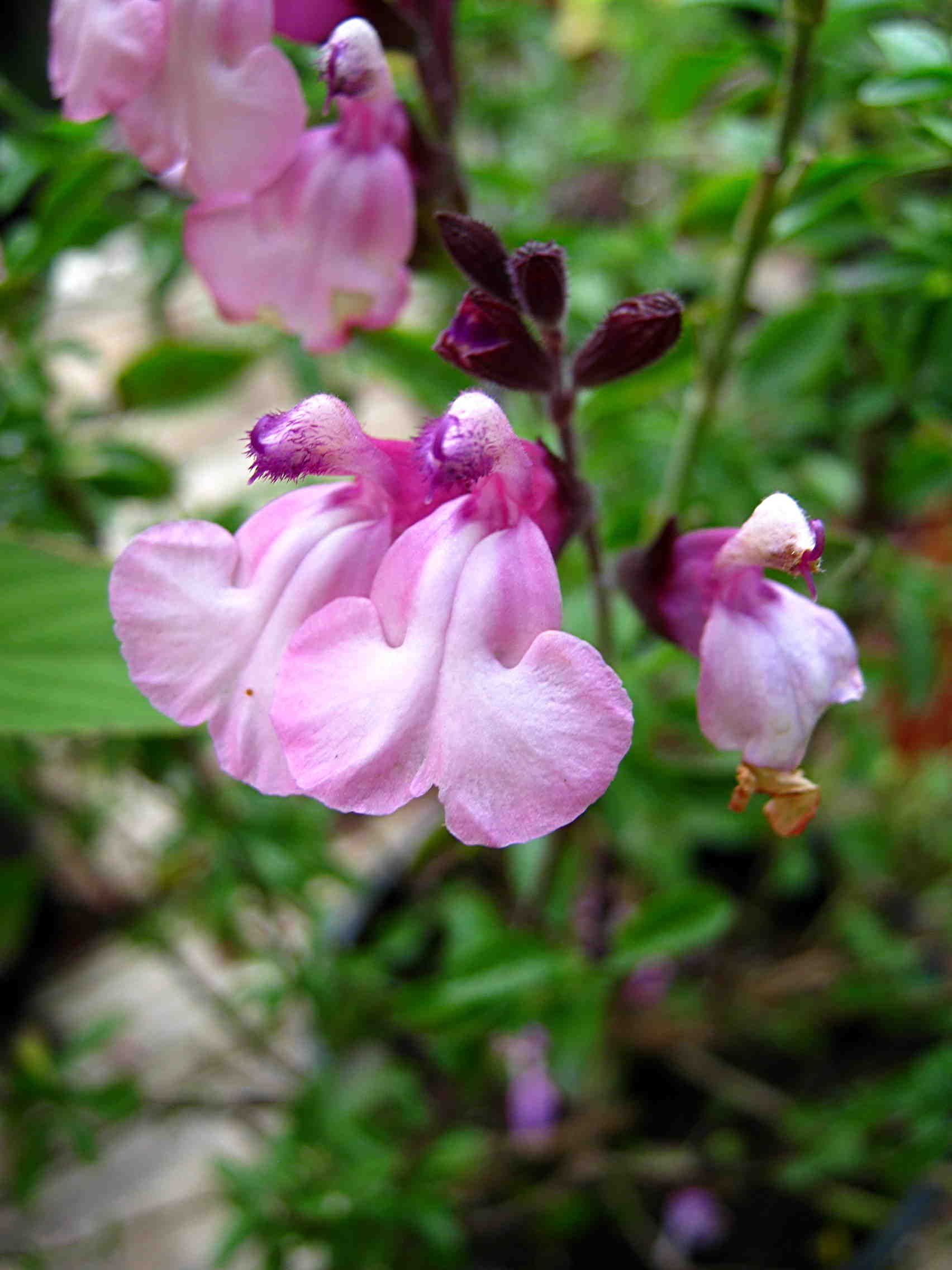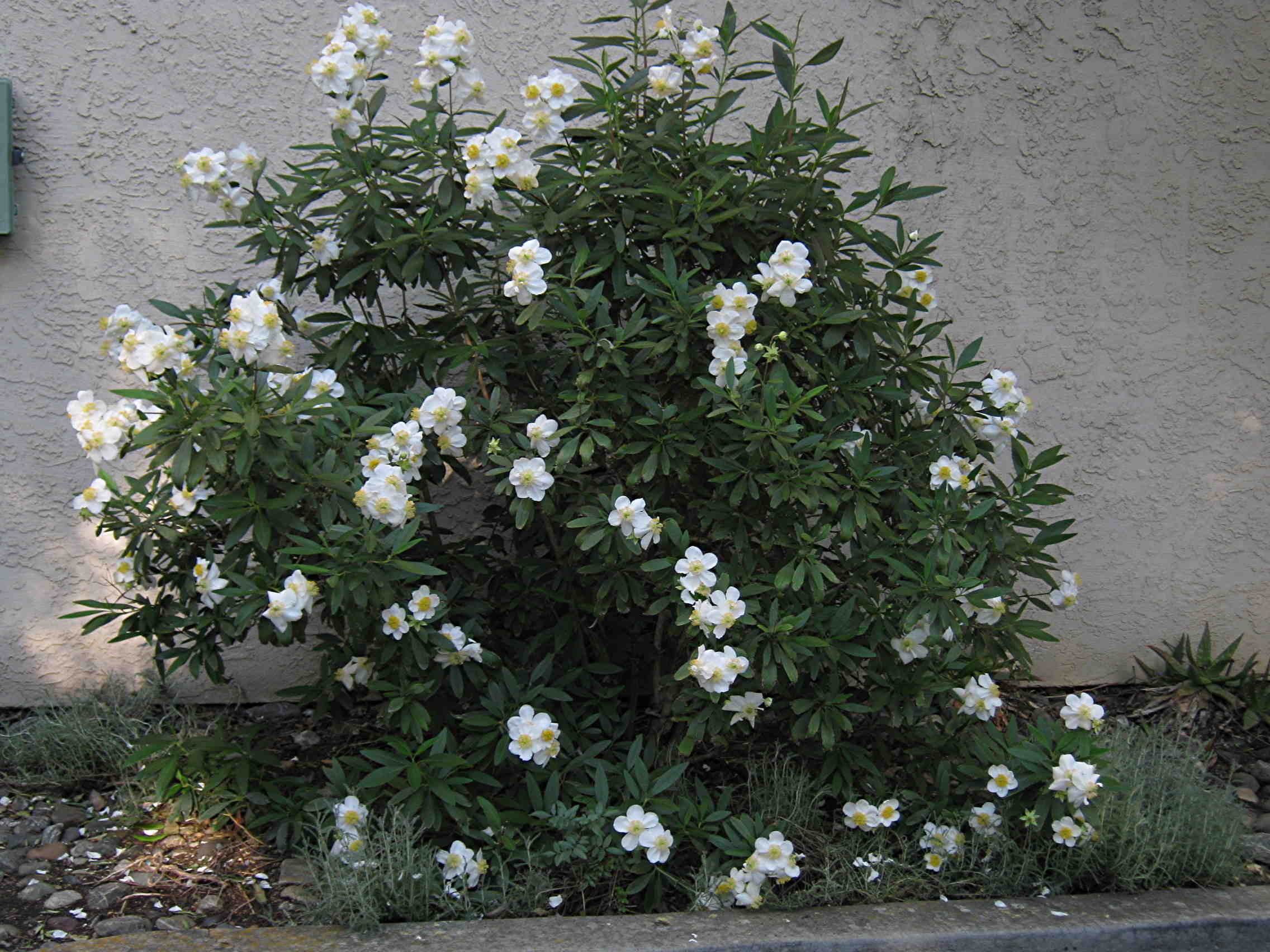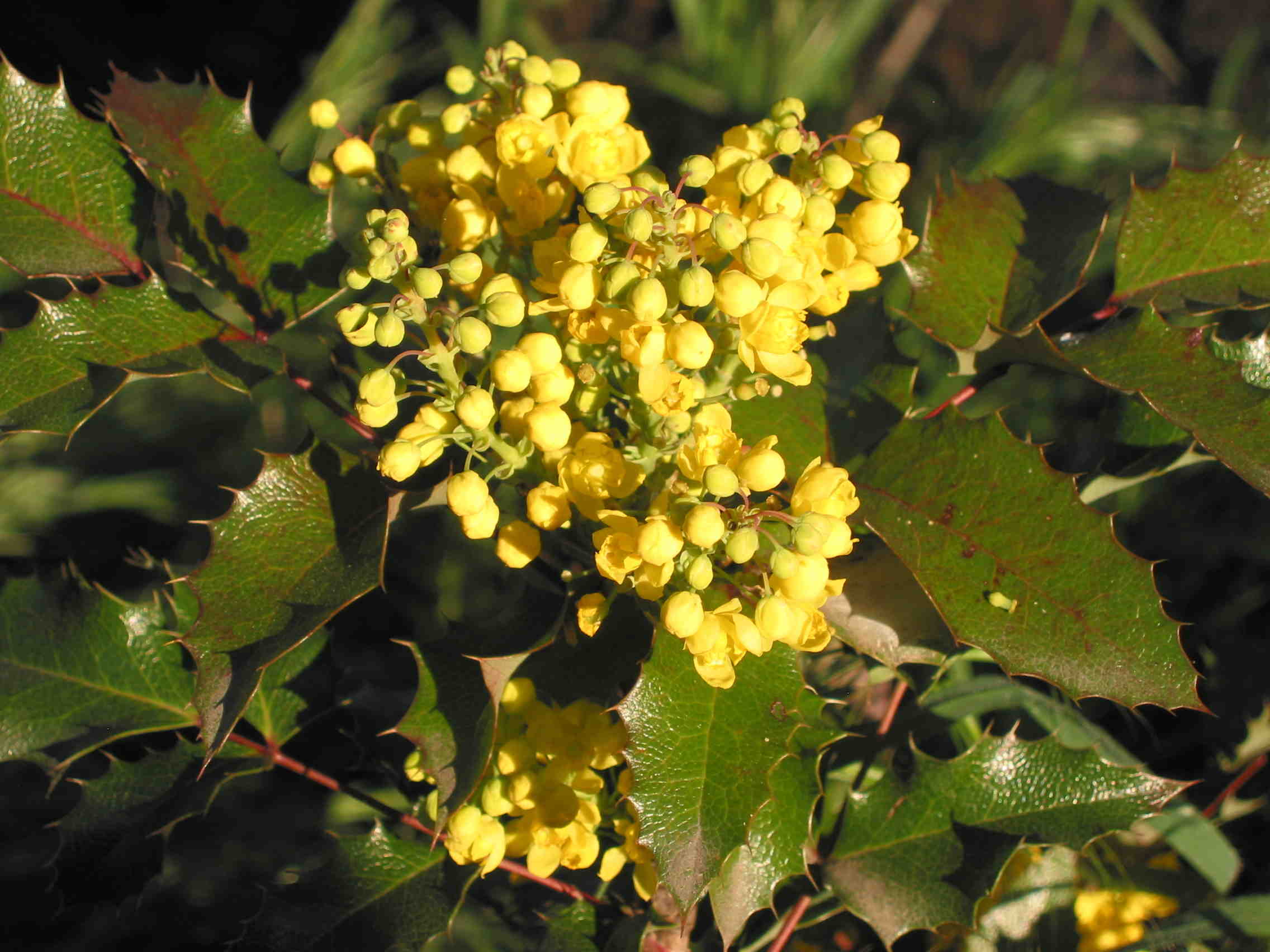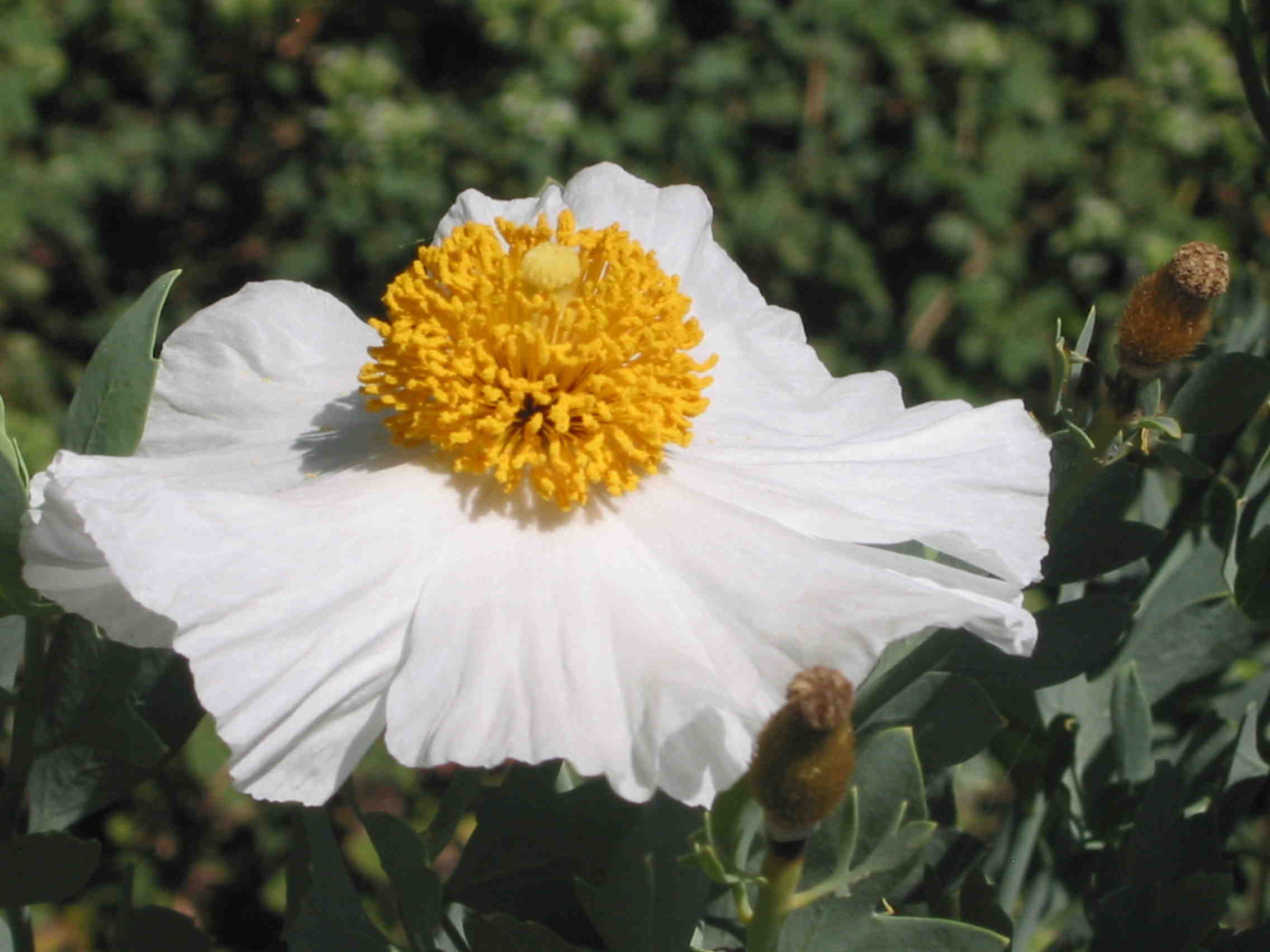
This is part of a continuing series of articles on plants that can grow and look good with low water. The focus here is on low to medium shrubs for very limited irrigation, especially natives. Low-water taller shrubs were discussed in our November 2011 article.
- Note that some California native plants require drought, as compared to tolerating drought. They'll die if you water them too often. In garden references you'll sometimes see the notation "needs good drainage" or "short-lived." Those are code for "susceptible to crown rot," meaning that if they get watered too frequently in warm weather they may get attacked by Phytophthora, a fungus-like organism that invades the plant at the crown and kills it swiftly. Many, but not all, of our native plants are vulnerable.
Watering deeply and infrequently, and avoiding mulch around the stem, are the best practices for avoiding crown rot.
Low and ground-cover shrubs
Botanical name: Arctostaphylos speciesCommon name: Manzanita
As a group I am leery of manzanitas because they are so easy to kill, being very sensitive to overwatering. But a couple of garden cultivars are less vulnerable. Howard McMinn grows to about three feet tall, four feet wide or more. It has a dense growth habit, with shiny green leaves that contrast nicely against the red stems.
Baccharis pilularis Twin Peaks
Dwarf coyote brush.
Very tough, drought-tolerant native. Great for attracting beneficial insects. Otherwise a dull, somewhat scruffy looking plant. Unbelievably resilient, so it earns its place on my list on that account. Nobody's going to say, "ooh, look at your coyote brush!" But you don't ever have to prune or even water it.
Ribes viburnifolium
Catalina perfume
Will grow in considerable shade, spreads steadily to make an attractive ground cover. Fragrant evergeen foliage. Light pink flowers in late winter attract hummingbirds; small red berries attract songbirds.
Salvias: sages.

Salvia splendens
Red Hot Sally
For many years, the annual Scarlet sage was the best-known member of Salvia. These showy flowers are planted in spring, bloom through fall, and then die with frost. But the blooms are non-stop and they attract hummingbirds as readily as their perennial and shrubby cousins.
 Salvia Pink Frills
Salvia Pink FrillsPatrick Worley, the breeder at Suncrest Nurseries who introduced this describes it as a "greggii type" to about 2 feet tall and wide. These lighter colors stand out nicely against the dark green foliage. A plant will have 30- 50 flowers at a time during autumn.
 Salvia Dancing Shadows
Salvia Dancing ShadowsThe breeder describes these as "painted icy pink and white flowers" on red-violet stems. Another profuse bloomer in the sun-loving, drought-tolerant Salvia greggii group.
 Salvia Golden Girl
Salvia Golden GirlYellow is the holy grail of Salvia breeders, and this is the closest yet. Suncrest Nurseries describes it as "very compact" to 18 inches, which makes it a low-grower in this group.
 Carpenteria californica
Carpenteria californicaShown here in May, the native Bush anemone gives several weeks of bloom in late spring. It is actually a rare species, growing only in a few sites in Fresno and Madera counties. But growers of native plants have popularized it for California gardens. Unlike many natives, it is not fussy about soil and can tolerate regular watering, but is also tolerant of drought.
 Mahonia aquifolium
Mahonia aquifoliumOregon grape
Ok, it's not native here, but it is native over on the northwest coast. Mahonia has bright yellow flowers in winter, edible fruit that attracts songbirds, and tolerates drought or watering, sun or shade. Prickly leaves resemble holly. This original species is tall and rangy, but new forms have more compact growth habit, shinier leaves, coppery new growth, and more abundant bloom.
The flowers of Salvias are fascinating up close. They are "bilabiate" which means "having two lips." There are often glandular hairs on the flowers and leaves. The stamens are fused into a lever, which bends down and deposits the pollen on the back of the visiting bee or bird as it probes the long flower tube. The female flower stigma develops next and is bent down to receive the pollen. The flower is adapted to many pollinators, rather than any specialized one. Salvias are always active with wildlife. Hummingbirds, butterflies, carpenter bees, and bumblebees are attracted to the flowers. Beneficial insects harbor on the foliage. Songbirds like the small seeds. A mixed planting of salvias, lavenders, rosemary, and daisies will give year-around color, help prevent garden pests, enhance pollination, and require very little water once established.
Southwestern native sages
Salvia greggii, S. microphylla, and more. These are the stars of the autumn garden, at their peak of bloom right now.
For gardeners, this is one plant group where there has been a sea change in availability of species, hybrids, and cultivars in the last couple of decades. My 1970 edition of the Sunset Western Garden Book lists ten species on about half a page, with only three cultivars. Native plant specialists carried a couple of species. In the herb section of your local garden center you could find common garden sage for use in your holiday turkey stuffing. Annual Scarlet sage was a popular summer bedding plant. That was about the extent of the Salvia trade.
Then in the early 1990's Salvia greggii, now called Autumn sage, started to show up. No named varieties, but it caught on quickly for the bright pink late summer and fall blooms. Now Salvias cover six pages in the new 2012 edition of Sunset. One grower has 30 to 40 varieties available.
What makes these important for Valley gardeners is that many of them come from hot, low-rainfall regions. Salvia greggii is native to the high deserts of southwest Texas and Mexico. Salvia microphylla, Graham's sage, comes from Southeastern Arizona and Mexico (it is recognizable by the much more fragrant foliage, which occurs in some of its progeny). When you bring these two together in a garden, they hybridize very readily and reseed happily. So now there are dozens of natural and intentional hybrids, in an ever-increasing range of colors.
For taxonomy buffs: the naturally occurring, original hybrids between S. greggii and S. microphylla and other species were given the name Salvia x jamensis. The 'x' indicates an inter-specific hybrid of known parentage. But that was a while ago. The exact parentage of many of the new cultivars is simply unknown at this point, so they often just have a cultivar name; e.g., Salvia 'Dark Dancer'. The genus name (Salvia) is properly italicized; the cultivar name should be in single quote marks. Neither is standard editorial practice in the news industry, but it is how you will usually see the name in journals and reference books.
Hybrids and cultivars in this complex group are generally 2 to 4 feet tall and wide. Most branch heavily from the base. S. greggii types tend to get woodier and taller, eventually a little rangy. You can cut these back in spring to keep them shorter and more compact. The bloom is light and steady in spring and summer, and absolutely profuse in fall.
The color range started in reds and pinks, then broadened to lavenders and purples. A light yellow form appeared; now there are some stronger yellow ones.
Every time I think I have a favorite, another variety comes along. In addition to those shown here, I have created a pinterest board of my Salvia pictures: http://pinterest.com/redwoodbarn/salvias/
California native sages.
Mostly spring-blooming, these have denser growth habits than the previous species and tend to get larger.
Salvia apiana
Silvery-white leaves give this the common name of White sage. Three feet tall and wide; white flowers, intensely fragrant foliage. Hardy to 20 degrees F or lower. This is the one used for burning in purification rituals. Hard to propagate and thus not common in the trade. It is easy to kill by overwatering.
Salvia clevelandii
Cleveland sage is a Southern California native that grows to about three feet tall and a little wider. It has attractive grey-green foliage, and tall whorls of blue flowers in late spring. A very useful shrub in low-water landscapes, it combines well with non-native low-water plants such as Cistus (rockrose), lavenders, and rosemary, as well as natives such as Ceanothus (wild lilac) and manzanita. A few cultivars: Allen Chickering has lavender-blue flowers; Winnifred Gilman's are darker blue.
I have found this plant often harboring ladybugs in the adult and larva forms in winter and early spring.
A few other native shrubs

Romneya coulteri
Can you see why it's called Fried-egg flower? Matilija poppy is the other common name of this Southern California native. A big (up to 8 feet tall!), spreading, somewhat coarse-looking plant with flowers that bob above the foliage in summer. Easy, tough, moderately invasive, tolerant of watering or drought.
Bush anemone
This slow-growing, tidy shrub to four to five feet, from our coastal mountain range, has shiny leaves and a compact growth habit. White showy flowers in late spring resemble anemones. Tolerant of sun or light shade.
Ceanothus species and varieties
Wild lilac
Attractive shiny leaves and fragrant blue flowers in spring. Water deeply and very infrequently in summer; they are notorious for dying abruptly in warm weather when they get watered too often. There are low spreading types. Centennial stays under a foot tall and spreads several feet. Yankee Point grows to two to three feet tall and spread six to eight feet or more.
The UC Davis Arboretum touts Valley Violet, a well-mannered low shrub with small leaves and unusual lavender-pink flowers.
Several varieties grow to six feet or so, some spreading wider. Julia Phelps has dark, small leaves and vivid cobalt-blue flowers; one of the showiest in bloom.
Ray Hartman, mentioned in the Nov. 11 article, is big, fast, and upright, tall enough to train as a screen or small tree to fifteen to twenty feet.
Mahonia aquifolium
Oregon grape
Native to the coast side of the coastal mountain range. Shiny leaves, bright yellow flowers in winter, blue berries that attract songbirds. Tolerant of sun but better-looking in some shade and tolerant of deep shade. Compacta is a denser, shorter variety. John Muir and Ken Hartman (a hybrid) are selections with denser foliage, spinier leaves.
As you change over your landscape for lower water use, consider some of these plants native to California and the southwest for their durability and beauty!
Previous columns about low-water plant choices in the Davis Enterprise columns here.
Look for the October and November 2011, January 2012 and June 2012 columns.
More pictures of Salvias here
and on Pinterest here.c 2012 Redwood Barn Nursery
www.redwoodbarn.com

Glad to see a post including Salvias. They are beautiful in the garden and attract so many pollinators. Thanks for sharing the info on the other natives. Do you think a bush anemone would grow in Washington west of the Cascades?
ReplyDeletevery interested in purchasing your salvia plants. but I live in the uk. can I buy them from you.. ?
ReplyDelete